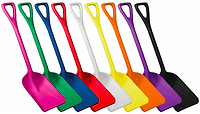Entire tomes of best practices, regulations, and guidance have been written about the importance of cleaning in food safety. However, when it comes to cleaning your sanitation tools, these topics are often covered in a single document. As for the equally important matter of choosing cleaning tools that are hygienically designed, even less is written.
Creating Hygienic Standards
The basic principles of hygienic design have been codified, thanks to the European Hygienic Engineering and Design (EHEDG) and 3-A Sanitary Standards Inc. (3-A SSI) groups. EHEDG and 3-A SSI both created standards that are often used to produce hygienically designed food manufacturing equipment. These standards, when combined with European Brushware Federation (FEIBP) standards, serve as a whole new set of guidelines for the hygienic design of sanitation equipment.
Benefits of Hygienic Design
Simply put, hygienic design matters because cleaning equipment is recognized as a major source of pathogens. In unpublished data from Campden BRI, Listeria monocytogenes was present on only 17 percent of floor swabs and 25 percent of drain swabs, and was rarely found on food processing equipment. However, Listeria showed up on 47 percent of swabs taken from cleaning equipment that regularly came into contact with food contact surfaces. In addition to the proper cleaning of sanitation tools, hygienic design is an important feature that reduces the number of gaps, seams, and crevices where microorganisms can multiply and hide.
But it’s not just about preventing the spread of microorganisms: Good hygienic design makes cleaning easier, saves employees time, and saves companies money. It also reduces the risk of foreign body contamination and increases product quality and safety.
Principles of Hygienic Design
Collected from the EHEDG design criteria and the FEIBP, these are the principles of hygienic design for brushware and other cleaning tools.
Tools should have the following characteristics:
• Free of crevices and contamination traps: They should have smooth welds and the absence of small holes, recesses, and sharp internal angles.
• Smooth surface finish (Ra < 0.8 mm): This excludes foamed plastic and wood blocks, as they often have rough surface finishes.
• Easy to clean and dry: They should be of one- piece construction, quick and easy to dismantle/ reassemble, or offer easy access to all areas for cleaning and disinfection.
• Made of food-safe materials: This excludes wood, glass, and resin.
• Well-constructed: Tools should be durable, which excludes foamed materials, along with those that are painted or coated.
• Nonabsorbent: Wood blocks don’t fit this criterion.
• Appropriately temperature and chemical resistant: Every tool should have stated temperature ranges.
• Nontoxic: Tools should not contain harmful substances like chlorine.
• Food-grade additives: All additives, including colorants, must be food-grade of a recognized standard and must not contain lead, mercury, or cadmium.
• No hollow or flagged fibers: This invites contamination and can offer space for microorganisms to multiply.
• Made with appropriate filling material retention: Bristle retention must be by means of oxidation-proof wire, recognized food-grade standard epoxy resin, or through fused construction.
• Hygienic product markings: Product markings like logos must use the best technical and hygienic methods possible.
Under section 5.1 of EHEDG’s design principles document, the group points out the major benefits of easy cleanability: “Equipment which is difficult to clean will need procedures which are more severe, require more aggressive chemicals, and longer cleaning and decontamination cycles. Results will be higher cost, reduced availability for production, reduced lifetime of the equipment, and more effluent.”
Although these principles were written for larger food production equipment, the points still stand for hygienically designed cleaning tools. They’ll require less aggressive chemicals and cleaning procedures, cost less, last longer, and increase overall food safety.
To learn more about hygienic design, please read our white paper here: remcoproducts.com/ust-white-paper. For information on how Remco and Vikan’s cleaning and material handling tools are designed with hygiene in mind, contact our customer support at cs@remcoproducts.com or at 317.876.9856.




